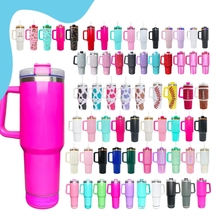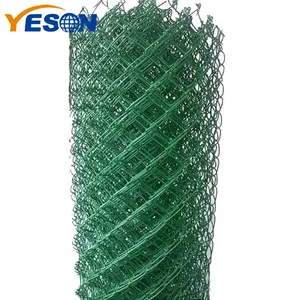In the realm of perimeter defense, chain link fencing materials are the industry's bread and butter, celebrated for their robustness and adaptability. Such fencing plays a crucial role in the protection of assets across residential, commercial, or industrial settings. Chain link fences employ an array of metals and finishes, each chosen for its unique attributes to cater to the varied demands of disparate environments and applications.
Types of Chain Link Fencing Materials
Diverse chain link fencing materials are on offer, each boasting distinct features. The wire gauge, for example, can differ, with the 9 gauge being a typical selection for its optimal mix of tensile strength and pliability. Fence heights and mesh dimensions also vary, with taller barriers providing enhanced security and finer meshes deterring small creatures. Specialty variants like PVC-coated cyclone wire add visual appeal and weather resistance, making them suitable for residential zones or athletic venues.
Structure of Chain Link Fencing
A chain link fence's architecture consists of several fundamental elements. Posts and rails constitute the framework, ensuring the fence's structural soundness. The chain link mesh, affixed to this skeleton using tension bars and bands, is crafted from interwoven steel wires that create a resilient and flexible diamond pattern. Gates are seamlessly incorporated for entry and exit, featuring hardware that combines security with user-friendly operation.
Materials and Their Properties
Metals such as iron, steel, and occasionally aluminum are the primary constituents of chain link fencing materials. Galvanized steel is favored for its anti-rust and anti-corrosion properties. For extra fortification, coatings of polyvinyl chloride (PVC) or polyethylene (PE) can be applied, enhancing the metal's longevity and offering a spectrum of color choices. These materials are selected for their durability, cost-efficiency, and straightforward installation.
Business Usages and Applications
Chain link fencing is essential in a variety of commercial contexts. It secures construction sites and safeguards machinery in the building sector. In agriculture, it encloses livestock within cattle and horse pens. Sporting venues employ it to surround playing fields and courts, while in transportation, it serves as highway fencing to deter trespassing and bolster safety. These fences add business value by ensuring security, marking perimeters, and mitigating theft or damage risks.
Functions of Chain Link Fencing
The chief purpose of chain link fencing is to establish a secure boundary without impeding sightlines. It is engineered to demarcate property borders, confine pets and livestock, and block unauthorized entry to sensitive zones. The fence's resilience allows it to absorb impacts with minimal detriment, rendering it ideal for locales frequented by ball sports or wildlife.
Features of Chain Link Fencing
Chain link fencing is distinguished by its rot proof and eco-friendly attributes. Its signature diamond weave offers a transparent barrier, ensuring protection without detracting from the landscape's visual charm. Customization options in hue, thickness, and finish enable the fencing to fulfill diverse roles while harmonizing with various settings. These characteristics differentiate chain link fencing from other barriers, striking a balance between visibility, sturdiness, and versatility.
Benefits of Chain Link Fencing
The advantages of employing chain link fencing materials are numerous. They present an economical option for extensive boundaries, demand minimal upkeep, and can endure for years with appropriate maintenance. The installation is uncomplicated, conserving both time and labor expenses. For enterprises, the minimal ownership costs coupled with the formidable security it affords make for a sound investment.
How to Use and Maintain Chain Link Fencing
Proper management of chain link fencing entails routine checks and immediate mending of any compromised sections. When selecting an appropriate fence, one should consider the site's specific requirements, such as the desired security level and the prevailing climatic conditions. Cleansing can be accomplished with basic household detergents, while upkeep typically involves monitoring for and rectifying any rust or slack fittings. Installations should adhere to the manufacturer's instructions or be executed by professionals to guarantee peak functionality.
Target Audience and Meeting Their Needs
The intended clientele for chain link fencing materials spans construction firms, agricultural operations, sports facility administrators, and transport regulators. The product satisfies their needs by offering a dependable security measure that is versatile enough to adapt to a range of environments and uses. Whether for a temporary barrier at a construction locale or a permanent boundary for an athletic field, chain link fencing delivers a pragmatic and effective solution.
In the realm of perimeter defense, chain link fencing materials are the industry's bread and butter, celebrated for their robustness and adaptability. Such fencing plays a crucial role in the protection of assets across residential, commercial, or industrial settings. Chain link fences employ an array of metals and finishes, each chosen for its unique attributes to cater to the varied demands of disparate environments and applications.
How does the environment impact the choice of chain link fencing materials?
The environment is a critical factor in the selection of suitable chain link fencing materials. Elements such as the local climate, soil composition, and exposure to corrosive agents like saltwater influence the decision for specific coatings and metal types. For example, in coastal regions, a vinyl or PVC coating is indispensable for combating saltwater corrosion. In industrial environments, a heavier gauge wire might be required to endure potential impacts or intensive usage.
What are the maintenance requirements for chain link fencing?
Maintaining chain link fencing is relatively simple yet vital for its long-term integrity. Periodic inspections to detect wear, such as rust or weakened connections, are imperative. Cleansing with gentle soap and water, coupled with regular tightening of the mesh and supports, preserves the fence's condition. For coated fences, it is crucial to inspect for and promptly repair any coating breaches to avert rust.
How can businesses ensure they are choosing high-quality chain link fencing materials?
Businesses aiming to secure high-caliber chain link fencing materials should seek suppliers on Alibaba.com that offer comprehensive product details and certifications. It is prudent to request samples or 3D models to personally evaluate the material's quality. Testimonials and ratings from other commercial purchasers can serve as invaluable indicators of a supplier's product reliability and excellence.







































 浙公网安备 33010002000092号
浙公网安备 33010002000092号 浙B2-20120091-4
浙B2-20120091-4